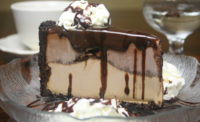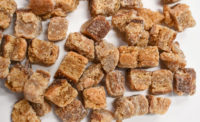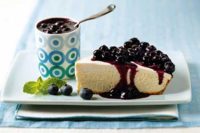For some, the jingle of an ice cream truck gets those Pavlovian juices and transports us back to summers past. While some of us will also always carry a torch for the Drumsticks and Fudgesicles of yore, today’s frozen dairy novelties are hardly preserved in amber. This is one sector that genuinely lives up to its “novelty” name. The latest frozen concepts give cupcakes, pie pops and the notorious Cronut stiff competition.
That should bring dairy developers and the category’s devoted fans cause for cheer. Marketing Manager Jillian Hillard of ingredient supplier PreGel America, Concord, N.C., said, “It’s a very exciting time to be in the frozen dessert industry.” Even so, she noted, “With so many trends and ideas swirling, the bar is being set high.”
The trick to clearing the bar — and maybe introducing a few novel trends while you’re at it — lies in keeping one eye on inspiration and the other on formulation.
What’s in a novelty?
According to researchers at Chicago-based Mintel, domestic retail sales of ice cream and frozen novelties are set to remain steady at a healthy $11.9 billion for the year now ending. No small part of that strength comes from innovation that’s breathing life into the dairy dessert category.
“The word ‘novelty’ is getting blurred with so many out-of-the-box items,” Hillard said, as everything from gourmet frozen pops and milk shakes to crepes and gelato panini (Italian for ice cream sandwiches) starts showing up in supermarkets. Just consider how much gelato has done for the frozen dairy case. A Mintel report credits it with keeping “the segment, and thus the category overall, afloat in recent years.”
Given gelato’s flavor variety and premium reputation, it is only natural that it would evolve into a driver of growth and innovation, Hillard said. And, she added, “Its Italian-heritage angle doesn’t hurt, either.”
Permission to indulge
Healthy yet indulgent: That’s a good way of summing up what consumers are looking for in frozen dairy novelties these days. While it’s true that the frozen-yogurt phenomenon emphasized dairy’s good-for-you side, “the case is being made again that it’s okay to indulge every once in a while,” Hillard insisted. She sees this not only in the prevalence of decadent flavor concepts like dulce de leche, cheesecake and chocolate peanut-butter crunch, but in broader trends, as well.
Take the rise of the New South — or at least the rise of newly launched Southern-inspired concepts. Hillard noticed the trend’s fingerprint in the development of frozen desserts “that emulate good ol’ Southern standbys like red velvet cake, banana bread pudding and caramel bourbon.”
And don’t forget the role that single-serve novelties play in easing consumers into a safer sort of indulgence. As Jon Vander Woude, director of marketing for Denali Flavors Inc., Wayland, Mich., explained, “portion control oftentimes gives the consumer permission to indulge.” Even better, he added, “Developing indulgent products with additional health attributes allows for health-conscious consumers who may have left the category a reason to return.”
The senses and the seasons
The lesson is that developers need to consider the whole package when developing frozen novelties, and that means appealing not just to the palate, but to all the senses. Consumers “eat with their eyes,” Vander Woude pointed out, so “inclusions and decorations play a key role” in signaling indulgence and building product demand.
“We’re seeing the continued rise of themed products designed and decorated for a specific holiday or event,” he added. “These themed items are grabbing more share of consumption given their novel appeal with the consumer.”
Indeed, Hillard said seasonal limited-time offers (LTOs) are “key.” Come autumn, she said, “Pumpkin rules and is proving that seasonal, on-trend LTOs are critical to gaining new streams of revenue and tugging at the heartstrings of consumers who are seasonally minded.”
But while we eat with our eyes — and, increasingly, with the seasons — we also eat with our teeth. And even in creamy dairy treats, the textural contrast of chewy, crunchy and crispy is always a winner. Enter inclusions and variegates. As Hillard said, “Variegates that are unique and offer something different from the standard inclusion are making waves — think apple pie pieces, lemon cookie bits and peanut butter crunch.”
Flavor forward
Add-ins deliver powerful bursts of flavor that can push creative boundaries. That helps explain why Beth Braciszewski of David Michael & Co., Philadelphia, said that flavors are where it’s really at when it comes to frozen dairy innovation.
“The most innovation we’ve seen is in flavor pairings and not necessarily in delivery via new novelty forms,” she said. “For example, the ice-cream sandwich format has been around for decades, but the new trick is pairing ice cream with more interesting cookies.”
So instead of the chocolate-chip-and-vanilla standard, try sandwiching salted-caramel ice cream between two snickerdoodles, or maple-marshmallow ice cream between red velvet cookies, she suggested.
In fact, Braciszewski said, “Some of the most creative frozen dairy desserts that we see are flavor-related. There’s an Earl Grey sriracha ice cream, a peanut-butter maple-tarragon ice cream, an everything-bagel ice cream and pumpkin curry to name a few.”
Millennial movers
Do a count of who’s digging into those flavors and you’ll likely have a list weighted heavily toward Millennials (those in their twenties and thirties) who “enjoy the new, the refreshing, the different,” Braciszewski said. “They’re willing to try and explore new products, new concepts and new flavors that might be a little too ‘blue sky’ or ‘out there’ for the average consumer.” And once they do, they “share” their impressions on social media at lightning speed. “This intensifies interest in the new,” Braciszewski continued, “and spreads the word better than traditional marketing.”
Clean up your label
To be sure, “Clean labels are more top of mind with today’s discriminating consumer,” Vander Woude said. While processors want to give savvy consumers the label transparency they demand, there’s a need, Hillard said, “to educate people on the processes of making frozen desserts, and what ingredients really mean.”
For example, “Consumers must understand that the ‘If-I-can’t-pronounce-it-it must-be-bad’ mindset is altogether ignorant,” she said. “Yes, there are questionable ingredients out there, and brands should be vigilant. But to get ice cream to maintain its creamy structure there are stabilizers and emulsifiers that are critical and aren’t bad for them.” After all, she noted, “Quality isn’t just about the ingredient list, but about the taste that’s there.”
Professor of food science Scott A. Rankin at the University of Wisconsin-Madison would agree. “Label brevity has become an important criterion for some consumers,” he said, “but whether it’s brief or extensive, the ice cream manufacturer should understand the chemistry and physics of their mix and what those ingredients do to deliver a consistent, enjoyable product.”
This is no simple task, as ice cream is a complicated chemical matrix. The novelty format complicates things even more. As Rankin pointed out, novelties’ smaller size exposes more surface area to the environment relative to the product’s mass. As such, that leaves frozen novelties “more susceptible to a variety of challenges such as moisture migration, sublimation and shrinkage,” he said. Making matters worse, the “inadequate packaging” of many novelties “may also contribute to functional defects such as product shrinkage,” he said.
Perhaps the most important formulation factor to consider when developing frozen novelties is the ice cream’s freezing-point depression, said Richard W. Hartel, a professor of food engineering at UW-Madison. Get that wrong and “ice cream will either be too hard or too soft and prone to forming coarse ice crystals in storage,” he noted.
Developers “go to extraordinary efforts when making ice cream to get the smallest possible ice crystals to give the smooth and creamy texture and taste” consumers crave, Hartel continued. But recrystallization, or the coarsening of ice crystals during storage, “is always a problem.” He points to stabilizers like guar and locust bean gum as helping prevent recrystallization, but concedes that “the best way to retain small ice crystals is to store product in a very cold freezer with no automatic defrost cycle — and, okay, you could eat it quickly, too.”
Quality control of the base ingredients — especially dairy-based ones — also “will critically influence the ultimate storage quality,” Rankin continued. “For instance, slightly stale dairy powders used to standardize the mix will most likely become even staler over the course of storage in the finished product.”
And that flavor really is the bottom line when it comes to designing a winning frozen novelty. For despite the justified focus on innovation in the category, “What this generation and others can agree on,” Hillard said, “is that if something is successful — classics such as vanilla or chocolate, for example — then businesses should stick to what they know until they’re ready to fully discern trends and create new products.”



